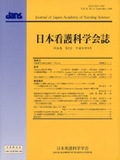Japanese
English
- 販売していません
- Abstract 文献概要
- 参考文献 Reference
要旨
本研究の目的は,機能性尿失禁リハビリテーションプログラム開発の基礎的資料を得るために,従来の看護計画の構造とその問題点を明らかにすることである.対象は,脳損傷後に機能性尿失禁をきたしリハビリテーション実施中の患者146名に実施された延べ783件の看護計画である.Mayringに従って説明的内容分析,要約的内容分析,構造化内容分析を行った.また,実施困難だった看護計画の問題を抽出し,原因別に分類した.
その結果,従来の看護計画は,「脳損傷後の自主的な排尿行動が行えるための精神的,身体的環境の調整介入」,「脳損傷後の新しい排尿動作スキル獲得のための介入」,「脳損傷後の特異的な障害から起こる排尿の問題に対する代替的な介入」の3領域からなり,それぞれ4,1,4の計9カテゴリーによって構成されていた.一方,看護計画を困難にする問題点は5カテゴリーに分類された.以上の結果を取り入れることにより,看護計画をより効果的にできる可能性が示唆された.
Abstract
The purpose of this study was to clarify the structure and insufficiencies of conventional nursing care plans for patients with functional incontinence of urine due to brain damage in order to develop rehabilitation programs for them.
We investigated 783 nursing care plans for 146 patients, who were 18 to 59 years old, and had functional incontinent of urine after brain damage. The structure of the nursing care plans was examined using Mayring's method including explicative content analysis, summarizing content analysis and structuring content analysis. Insufficiencies of the care plans were classified according to reasons of failure.
We found that the structure of conventional the nursing care plans consisted of 3 domains and 9 categories. The first domain was formed from interventions to manage psychological and physical environments, and was classified into 4 categories such as stabilization of the circadian rhythm. The second domain consisted of interventions to help patients to obtain new behavioral skills. The third domain consisted of interventions to prepare alternative or compensatory techniques for dealing with urinary problem specific among patients with brain damage, and was divided into 4 categories such as introduction of an alternative communication method. Insufficiencies of the care plans were classified into 5 categories.
These findings suggest that nursing care plans for patients with functional incontinence could be more effective if they were restructured according to 3 domains and 9 categories and checked for 5 categories of insufficiencies which had been clarified in this study.
Copyright © 2006, Japan Academy of Nursing Science. All rights reserved.


